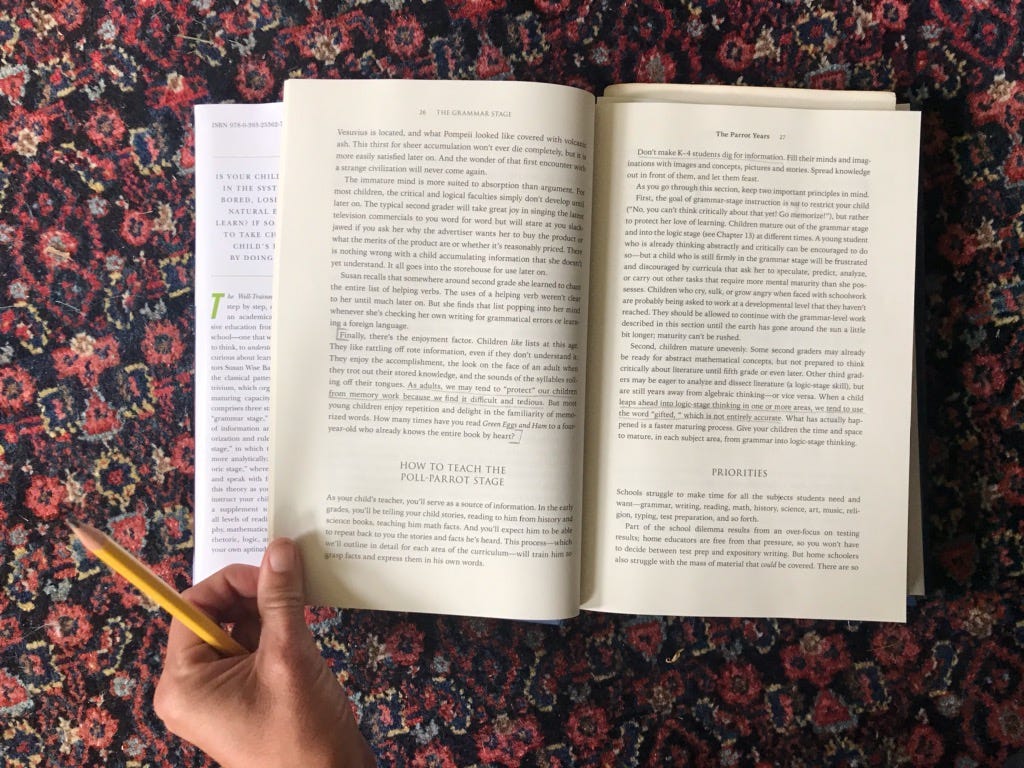It’s raining today and the girls have been living in a tent in the yard since last night. Someone just brought a tray of oatmeal bowls outside, under my watch. Our garden is flourishing, but I’ll still be buying a whole parcel of vegetables from a professional at the farmer’s market later this afternoon. The first monarch caterpillars are cutting their signature half-moons into the leaves of the milkweed. I’ve been making an afternoon focaccia almost every day, to cover for the fact that the only other thing planned for dinner is a salad and hot dogs. As always, my brilliant bread mentor is Alexandra, her recipe for overnight focaccia is here.
My kitchen is strewn with dishes but I’m typing this up for you in the midst of them anyway. This newsletter has photos, be sure to enable them in your email browser if you want to see them.
I hope this summer your family is experiencing a few of what we consider to be the best side effects of school-at-home life: eased sibling companionship, boredom, downtime, and wearing the same perfect superhero outfit four days in a row.
To begin, four strategies as you consider the coming school year:
1/ Read Ahead with No PressureReading homeschool curriculum strategies over the summer is wildly easier than reading them the rest of the year. I’m not sure why this is. But the classic how-to of classical education at home, The Well-Trained Mind, is suddenly readable and wonderful for me right now. I’m giving it an hour a day, and I am making great progress. I spent a long time being intimidated by it, but (like nearly everything I avoid) it turns out: it is fantastic.

Even if “Classical” doesn’t sound like your thing (I likely will not be pulling off 30 minutes of grammar three times a week), their approach is informative and inspiring.
A parent in need of being especially frugal armed with this book could likely plan a homeschool curriculum with just this, a few digital downloads, and a library card.
With homeschool resources I always like to note/warn whether a title has religious foundations or reference point, The Well-Trained Mind does not. The authors are Christian but make special emphasis to make their text secular.
2/ Order Ahead Decide on your curriculum and order it ahead as much as you can. The sooner you order, the sooner the books arrive. Publishers often run sales and promotions over the summer before September.
Give yourself time after bedtime to page through the books you’ve chosen and see if they meet your expectations.
After that, we like to wrap them up in brown paper, label them, and present them as back-to-school gifts in September. Curriculum isn’t cheap, and it is a gift to your child—why not treat it as such?

3/ Order Less Don’t buy everything you want to. Treat it like packing for a trip—wherein you lay everything out on your bed and then see what you can take away while still maintaining your effortless style.
So: write down everything you’re considering buying, with the prices, and how many children this curriculum will be useful for, then cross out ten or twenty percent of it.
4/Plan for the Breaks Here’s a staple every homeschooling parent counts on: breaks.
So plan for them!
This means if you have a toddler’s nap coming up, you’ve planned exactly what you’re going to do during that nap, be it 30 minutes or 60.
This means a quiet time every single afternoon for the whole family, when you are not available to talk for two hours.
It can also mean a break week every other month, to take a few steps back, evaluate how things are going and revise the schedule.
All sorts of things—childhood, the morning, pregnancy—seem long until you see how soon the break is coming.
Unschooling: a Podcast I Enjoyed 
image by Jodi Mockabee
I loved listening to Jodi Mockabee explain their year of unschooling on this Wild & Free podcast. If you’ve follow Jodi Mockabee, you know that she continues to practice a form of unschooling with her five children; this talk is from 2016 as they began this approach. Unschooling can be a slippery term to understand, much less visualize what your life would look like well doing it; Jodi’s talk is honest and inspiring.
I have linked to the Apple podcast listing, but it is episode 5, “For the Love of Learning,” and you can find it through any podcast service. A 30 minute talk, her talk begins 8 minutes and 50 seconds into the podcast.
A Post I Wrote Up Last MonthOur Favorite Curriculum from the Past Year: I wrote this it on my personal blog, Erstwhile Dear. Curriculum and Homeschool Resources I Love.
It opens with a bit of a meander.
A Schedule You Can Buy Parents of PreK, Kindergarten, & First Grade...an affordable approach I am seeing recommended, and I spent some time reviewing this week. A week-by-week scheduled story-based approach (sample pictured below) for your whole year with scripted copy work, family activities, recipes to make together, and black-line maps for coloring.

This approach but would require more prep work from you in finding the titles they suggest to read, ahead of time. This approach is less rigorous than the Classical Conversations style that I am currently very happy with, but I think it could be an excellent beginning for families with several children around the kindergarten age.
Click here to visit their site and download a sample copy. The Peaceful Press is Christian with content based on the Bible. The Peaceful Press. $50 for the digital download.
And Finally, a Quote for YouOn each library visit, I had them check out the following books: one science book, one history book, one art or music appreciation book, one practical book (a craft, hobby, or “how-to”), a biography or autobiography, a classic novel (or an adaption suited to age), an imaginative storybook, a book of poetry. They were allowed to choose the titles, but I asked them to follow this pattern. And they were also allowed to check out other books on any topic they pleased.
-Jessie Wise on homeschooling with no curriculum in the ‘70s, quoted from A Well-Trained Mind.
Thank you for reading!
With affection for this journey we’re on together,
Rachael



